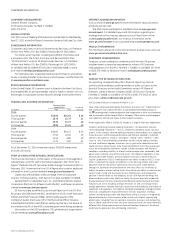GE 2010 Annual Report Download - page 137
Download and view the complete annual report
Please find page 137 of the 2010 GE annual report below. You can navigate through the pages in the report by either clicking on the pages listed below, or by using the keyword search tool below to find specific information within the annual report. GE 2010 ANNUAL REPORT 135
non-interest bearing assets. See “Securitization” and “Variable
Interest Entity.”
NONCONTROLLING INTEREST Portion of shareowners’ equity in a
subsidiary that is not attributable to GE. In financial statements
prior to 2009, this was labeled minority interest and was pre-
sented outside of shareowners’ equity.
OPERATING PROFIT GE earnings from continuing operations before
interest and other financial charges, income taxes and effects of
accounting changes.
OPTION The right, not the obligation, to execute a transaction at
a designated price, generally involving equity interests, interest
rates, currencies or commodities. See “Hedge.”
PRODUCT SERVICES For purposes of the financial statement display
of sales and costs of sales in our Statement of Earnings, “goods” is
required by U.S. Securities and Exchange Commission regulations
to include all sales of tangible products, and “services” must
include all other sales, including broadcasting and other services
activities. In our Management’s Discussion and Analysis of
Operations we refer to sales under product service agreements
and sales of both goods (such as spare parts and equipment
upgrades) and related services (such as monitoring, maintenance
and repairs) as sales of “product services,” which is an important
part of our operations.
PRODUCT SERVICES AGREEMENTS Contractual commitments, with
multiple-year terms, to provide specified services for products in
our Energy Infrastructure and Technology Infrastructure installed
base—for example, monitoring, maintenance, service and spare
parts for a gas turbine/generator set installed in a customer’s
power plant.
PRODUCTIVITY The rate of increased output for a given level of
input, with both output and input measured in constant currency.
PROGRESS COLLECTIONS Payments received from customers as
deposits before the associated work is performed or product
is delivered.
QUALIFIED SPECIAL PURPOSE ENTITIES (QSPEs) These were entities
excluded from consolidation until the effective date of ASU 2009-
16 and ASU 2009-17. The activities of QSPEs are significantly
limited and entirely specified in the legal documents that estab-
lished the entity. There also are significant limitations on the types
of assets and derivative instruments they may hold and the types
and extent of activities and decision-making they may engage in.
RETAINED INTEREST A portion of a transferred financial asset retained
by the transferor that provides rights to receive portions of the
cash inflows from that asset.
RETURN ON AVERAGE GE SHAREOWNERS’ EQUITY Earnings from continu-
ing operations before accounting changes divided by average
GE shareowners’ equity, excluding effects of discontinued opera-
tions (on an annual basis, calculated using a five-point average).
Average GE shareowners’ equity, excluding effects of discontin-
ued operations, as of the end of each of the years in the five-year
period ended December 31, 2010, is described in the Supplemental
Information section.
RETURN ON AVERAGE TOTAL CAPITAL INVESTED For GE, earnings from
continuing operations before accounting changes plus the sum of
after-tax interest and other financial charges and noncontrolling
interests, divided by the sum of the averages of total shareowners’
equity (excluding effects of discontinued operations), borrow ings,
mandatorily redeemable preferred stock and noncontrolling
interests (on an annual basis, calculated using a five-point aver-
age). Average total shareowners’ equity, excluding effects of
discontinued operations as of the end of each of the years in the
five-year period ended December 31, 2010, is described in the
Supplemental Information section.
SECURITIZATION A process whereby loans or other receivables are
packaged, underwritten and sold to investors. In a typical trans-
action, assets are sold to a special purpose entity, which
purchases the assets with cash raised through issuance of ben-
eficial interests (usually debt instruments) to third-party investors.
Whether or not credit risk associated with the securitized assets
is retained by the seller depends on the structure of the securiti-
zation. See “Monetization” and “Variable interest entity.”
SUBPRIME For purposes of Consumer related discussion, subprime
includes consumer finance products like mortgage, auto, cards,
sales finance and personal loans to U.S. and global borrowers
whose credit score implies a higher probability of default based
upon GECC’s proprietary scoring models and definitions, which
add various qualitative and quantitative factors to a base credit
score such as a FICO score or global bureau score. Although FICO
and global bureau credit scores are widely accepted ratings of
individual consumer creditworthiness, the internally modeled
scores are more reflective of the behavior and default risks in the
portfolio compared to stand-alone generic bureau scores.
TURNOVER Broadly based on the number of times that working
capital is replaced during a year. Current receivables turnover
is total sales divided by the five-point average balance of GE
current receivables. Inventory turnover is total sales divided by a
five-point average balance of inventories. See “Working capital.”
UNPAID CLAIMS AND CLAIMS ADJUSTMENT EXPENSES Claims reserves for
events that have occurred, including both reported and incurred-
but-not-reported (IBNR) reserves, and the expenses of settling
such claims.
VARIABLE INTEREST ENTITY (VIE) An entity defined by ASC 810,
Consolidation, and that must be consolidated by its primary
beneficiary, the party that holds a controlling financial interest.
A variable interest entity has one or both of the following charac-
teristics: (1) its equity at risk is not sufficient to permit the entity
to finance its activities without additional subordinated financial
support from other parties, or (2) as a group, the equity investors
lack one or more of the following characteristics: (a) the power to
direct the activities that most significantly affect the economic
performance of the entity, (b) obligation to absorb expected
losses, or (c) right to receive expected residual returns.
WORKING CAPITAL Represents GE current receivables and inven-
tories, less GE accounts payable and progress collections.

















